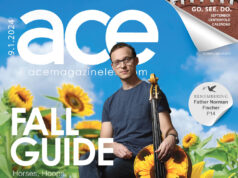
This one is reprinted from Ace’s March 19 issue, page 5, on stands now.]
WHAT LEXINGTON NEEDS: Two Way Streets
by Van Meter Pettit
In a merged urban county where we have pledged for 50 years to preserve two-thirds of the land area as a world heritage monument for our signature equine industry, it should be clear to everyone that our economic future rests on how densely and carefully we develop the core of our city. If we choose to maintain our unique rural character, whatever land remains inside our urban boundary must become perpetually more dense and productive. To quote our recent 2040 survey, we want Lexington to have a “Great City Life in a Productive Rural Paradise.” Outside consultants and local advocates have relayed to us repeatedly that if we want to compete on a national level for jobs and business we must develop a downtown that is as compelling in nature as our rural landscape. Every parcel of every block in our city’s center needs to be viewed as the seed corn for a future harvest.
From the observations made by executives of Toyota, Lexmark, and UK Hospital we now understand that a weak and lackluster downtown is not just an embarrassment, it is a critical deficiency that will relegate us to second- or third-tier status among American cities. If we do not generate an optimal climate for urban culture, growth, and innovation, we will watch our creative businesses and college graduates move away to better job environments. Despite the recent flourish of downtown masterplanning and urban mixed-use development, Lexington has yet to commit faithfully to optimizing our downtown. Significant aspects of our 2006 downtown masterplan have been set aside or watered down.
Though motivated by good intentions and a concern for time and money, critical aspects of our most recent streetscape plan deviate profoundly from our first masterplan in ways that need debate and scrutiny. What is most time-critical at present is the mandate to convert our downtown streets back to two-way traffic. After thousands of hours of public input, the 2006 masterplan was emphatic about downtown street conversions. And yet the latest streetscape plan suggests that we redevelop Vine and Main as one-way streets. The conversion of our once two-way streets into a one-way system in our downtown is a ’60s era experiment that has failed. Our once vibrant downtown is a mere shadow of its former self. Converting our urban byways into a confusing labyrinth of restricted intersections and one-way streets has discouraged pedestrian and commercial life. Many of our best downtown landmarks and commercial property are visually inaccessible because of the one-way traffic flow. Aside from some attractive spots here and there, downtown has acres of asphalt lots and marginally used real estate. A growing chorus of visiting consultants all echo what is now a national consensus: One-way streets are good for moving commuter traffic and very bad for downtown business. Scores of cities across the U.S. have converted one-way streets back to two-way to improve their urban environments.
Since our long-term future depends on a strong and growing urban economy, it would follow that we are busily converting our one-way streets back to their original two-way condition. Sadly this is not the case.
Despite every indication that downtown would benefit from these conversions, it has been several years since ANY conversion large or small has been made. In fact we are poised to invest millions of dollars at a time of scarcity to improve Main and Vine as one-way streets. We as a community have said over and over that we need a “24/7” downtown, but the decision to renew this failed urban experiment is inspired by a two-hour-a-day drive-through mindset.
It is understandable that our government is concerned that a delay in our daily commute will generate public wrath. But the debate over commute times and two-way conversions has never been put clearly to the public in the context of the well-observed economic merits. This issue has been debated all over the country already and the consensus from scores of communities is consistent: two-way conversions, while temporarily disruptive and controversial, are a net benefit for the economy and the life of the city.
Urge the council and mayor to vote for a clear mandate for two-way conversions with a specific timetable for each pair of streets. Although it will not be quick, cheap, or easy, we eventually need to convert all our major streets back to two-way if we want to optimize conditions for development and commerce downtown. How do we expect to make our city what it needs to be without reversing one of the clear obstacles to its redevelopment?
This issue needs to be clearly resolved for all subsequent planning decisions to be made coherently. If this remains an avoided debate, it will be a source of ambiguity sure to discourage confidence and investment. We will likely make costly mistakes as a city down the road without a clear mandate to guide us. If it is clearly explained, Lexingtonians all want what is best in the long-term rather than what is cheapest or most expedient.
We all want a growing economy and a bright future so our children and grandchildren can grow up in the Bluegrass. Our economic future depends on an optimized and reinvigorated urban core. This major issue was recommended in 2006 and now warrants timely resolution and implementation.
What Lexington Needs To Do:
1) Show up 3pm Tuesday, March 24 at LFUCG and ask for two-way streets.
2) Email jmcchord@lfucg.com to register public input.
Van Meter Pettit is president of Town Branch Trail Inc, a 501c3 nonprofit dedicated to advocacy for the creation of a multi-use trail linking downtown Lexington with its equine landscape via the historic Town Branch corridor. He was one of Ace’s first contributors when it was founded in 1989.




